Also known as “extreme waves” or “freak waves”, rogue waves are large waves that can pose serious risks to ships, oil platforms, lighthouses and cruise ships.
While they may be rare, they are very real.
It has been estimated that around ten 80ft+ rogue waves exist at any given moment.
Although that sounds like a lot, we’re talking about all of the world’s oceans, which span 140 square miles, so the likelihood of them appearing is infinitesimal.
What is the Definition of a Rogue Wave?
A rogue wave isn’t simply a large wave that has the potential to do damage.
There is an actual definition.
Firstly, rogue waves are distinct from tsunamis.
They are caused by random and unexplained events while tsunamis are caused by the severe and sudden displacement of water resulting from a seismic event.
Secondly, the height must be more than double the Significant Wave Height (SWH), which is the mean average of the largest 1/3rd of waves in recorded history.
It’s a pretty specific categorization, but it’s also one that covers a wide spectrum of wave heights.
What Causes Rogue Waves?
Rogue waves are still an active field of research and while we are learning a lot about how they form, how long they last, and what damage they can do, there is still a lot that we don’t know.
There are a few different ideas concerning how rogue waves form, including the following:
- Focusing by Currents: As seen near to South Africa, this describes a phenomenon whereby a current is drawn into an opposing current causing a compression of wave trains that forms into a big wave.
- Diffractive Focusing: The shape of the coast directs small waves to converge into a big wave.
- Nonlinearity: Big waves are formed by gaining energy from smaller, unstable waves.
- Normal: The idea that freak waves are not “freakish” or “unusual” at all and are actually just a rare part of natural wave formation.
- Wind Wave Causes:The idea that standard wave-wind interactions, in combination with freak events, causes rogue waves.
Where have Rogue Waves Occurred?
Rogue waves are very rare but there have been a few reported encounters over the last century and a half.
Some of them have been confirmed as being rogue wave events, others are only suspected:
- Eagle Island Lighthouse (1861): A lighthouse off the coast of Ireland was destroyed by a suspected rogue wave. The cliffside spanned 133 feet and the lighthouse itself was 87 feet, hinting at a massive rogue wave.
- RMS Etruria (1903): Reports suggest that the RMS Etruria was just several hours away from the port (in New York City) when it was hit by a 50-foot wave. Some of the passengers on the desk were injured and one was killed.
- Andrea Gail (1991): The Andrea Gail disappeared with 6 crew members off the coast of Nova Scotia. Buoys in the vicinity of the disappearance recorded waves of up to 100 feet and the crew members were never seen again.
- Draupner Wave (1995): The Draupner Wave was the first rogue wave to be recorded using scientific equipment. It generated huge interest in the scientific community as it fell outside of known wave models. The wave measured 84 feet and was recorded in the North Sea, 100 miles south of Norway. It is also known as the “New Year’s Wave” as it occurred on January 1st, 1995.
- Queen Elizabeth 2 (1995): The master of the ship described a 95ft feet wave that occurred in the North Atlantic, describing it as being akin to the “White Cliffs of Dover”, with the ship “surfing” the monstrous walls of water to stay afloat.
- RSS Discover (2000): An oceanography vessel recorded waves of up to 95 feet off the shores of Scotland. They were the largest waves recorded in the open ocean.
- Ballena (2000): The Ballena, a research vessel operated by the National Oceanic and Atmospheric Administration (NOAA), was destroyed by a 20-foot wave. The ship capsized and eventually broke apart against the rocks.
Some of history’s biggest mysteries have also been linked to possible rogue waves.
In 1900, for instance, 3 lighthouse keepers famously disappeared from the Outer Hebrides.
Some believe that one of the men killed the others and then himself, others hypothesize that one of the men drown and the others went in after him, but there are also those who point to a possible rogue wave as being the culprit.
It has been suggested that these waves spelled the end for famous ships like the Mary Celeste, and while it’s unlikely in this case, it is entirely plausible that these monster waves would have destroyed a few warships or merchant ships during the times of great empires such as the Athenians, Romans, Carthaginians, and even the Vikings.







